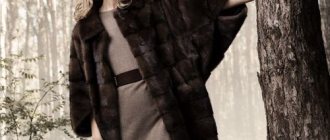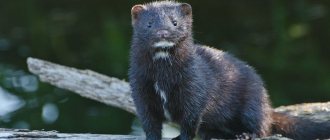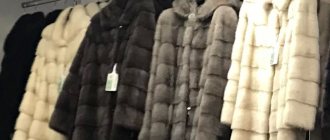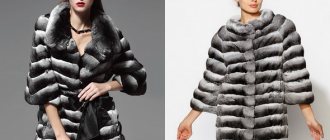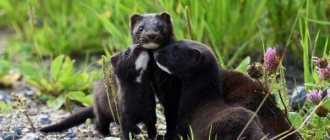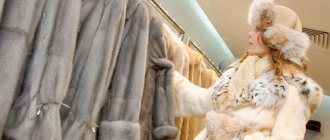There are many varieties of mink today. In addition to the main species, breeders artificially breed new breeds to obtain good and high-quality fur. These animals themselves are very cute, nimble creatures of nature that prefer a semi-aquatic lifestyle. Their fur is very pleasant to the touch, has a soft underfur and hard guard hair. Previously, when animal skins were not used for industrial production, animals were not bred en masse. Today, mink fur is highly valued in the fur industry, almost on a par with expensive sable fur. Therefore, many farms are now engaged in breeding and raising various types of minks, since this activity is very profitable.
If we take into account all types of animals, then today we can count 340 varieties of mink. They all have common characteristics, but differ in habitat, fur color, habits and habits. Among them, the most common are two breeds of mink: European and American. But it is worth noting that other species are also highly valued in the fur industry.
Who is Mink?
Mink is a small predator from the mustelid family, which makes them similar to martens, otters, badgers and ferrets. Minks love to settle along the banks of rivers and large bodies of water, since the basis of their diet is fish, frogs and crayfish. However, the animal does not disdain small rodents and birds.
As a home, the animal uses either its own dug holes or those of others. For example, an abandoned burrow of a mole, a water rat, or even a low-lying hollow of a tree growing next to a pond would be suitable for this role.
Today, there are two species to which the name mink is applied—the American mink and the European mink. These are quite close, but still separate species. A species is an evolutionarily established collection of individuals, characterized by a single... animal. They are very similar in appearance, lead a similar lifestyle, but do not interbreed in the wild, and therefore are ecological competitors of each other.
Nutrition
Since the mink is a wild animal, a semi-aquatic inhabitant, its food mainly consists of various fish, crustaceans, snails, mollusks, water rats, snakes, and frogs. The animal hunts land animals and birds, and does not disdain insects.
Not far from villages, domestic chickens and ducks often disappear due to the fault of minks. It prefers to eat fresh prey, only during a period of starvation for up to 3-4 days can it switch to stale meat or pick up food waste from houses.
With the approach of cold weather, the mink makes food reserves in the form of bitten or headless frogs, mouse-like rodents, minnows, perches, squints, and occasionally birds. Loves to replenish pantries and takes care of the freshness of savings.
Domestic minks are fed mainly with meat and fish feed with the addition of vegetables, grains, dairy, and vitamin components. An appropriate diet is selected for each biological period. In summer, due to the accumulation of energy, protein and vitamin foods are increased; in winter, less nutritious feed mixtures are used.
European mink
European minks have an elongated arched body and powerful short limbs. The average body length is 35-40 cm with a weight of just under 1 kg. Including the tail, the length is up to 60 cm. The paws have interdigital membranes, which simplifies hunting in the aquatic environment. The skin is covered with dense fur with a thick undercoat that practically does not get wet. Thanks to this, animals tolerate low temperatures, including cold water. The wool is colored predominantly dark brown. A characteristic feature is also the white muzzle, thanks to which the mink always looks very funny in the photo.
Until the middle of the last century, the European mink was widespread throughout almost all of Europe, with the exception of the north-west and the far south. However, to date, its habitat has narrowed to the Vologda and Arkhangelsk regions of Russia, as well as small isolated enclaves in Spain, Romania and the Baltic states.
The reasons for the disappearance of the animal from most of its historical range remain unclear, since not a single theory in this regard has been properly confirmed. It is believed that urbanization and the spread of the American mink in Europe only spurred the extinction of the “European” mink, but were not the original causes of this process.
American mink
The American mink is very similar in appearance to its European relative, but genetically it is closer to sables and martens. It is believed that “Americans” and “Europeans” arose as a species. A species is an evolutionarily established set of individuals characterized by a single ... independently of each other (that is, they do not descend from a common ancestor), and external similarity is the result of evolution in identical living conditions.
The body length of the “American” reaches 60 cm, and including the tail - 90 cm. The weight of an adult varies between 2-3 kg. The swimming membranes are poorly developed, but the fur cover is much thicker than that of the “Europeans” and is colored black and gray. In addition to size, the key difference between the American mink and the European one is the color of the muzzle: the “American” mink has only the lower lip and chin painted white, while the “European” mink has the entire muzzle white.
The historical habitat of this species is North America. Minks inhabit ¾ of the continent: they are not found only in the extreme northeast of Canada, the southwest of the United States, Mexico and the countries of the Isthmus of Panama. When the boom of industrial fur farming began in the 20th century, American minks were brought to Europe and the USSR for breeding in order to obtain valuable fur. The individuals that found themselves free quickly multiplied and occupied the ecological niche vacated by the extinction of the European mink. Today, American women are found everywhere in northern Europe and northern Asia, as well as in Japan.
The lifestyle and habits of the “American mink” are generally similar to the European mink, but thanks to their more massive body, they can hunt both small and relatively large prey, for example, muskrats and even poultry.
Reproduction and offspring
The mating season for the European mink lasts from February to April, and noisy fights often occur between males, accompanied by loud squealing from rivals. Due to the fact that the mating season begins even before the snow melts in most of the range, the places where the mink rut takes place are very clearly visible thanks to the trails trampled by females along the banks, called leks. After mating, males and females each go to their own territory and if their paths cross again before the next rut, it is only by chance.
Pregnancy lasts from 40 to 43 days and ends with the birth of four or five cubs, although, in general, there can be from two to seven. The babies are born blind and helpless; the female feeds them milk for up to 10 weeks. By this time, young minks begin to gradually go hunting with their mother, and by 12 weeks they become independent.
This is interesting! Despite the fact that minks are not related to the canine family, their cubs, as well as those of other mustelids, are usually called puppies.
Until autumn, the family lives together, after which the grown cubs go in search of suitable areas for them. Minks reach sexual maturity at approximately 10 months.
Return to content
Domestic mink
Until the second half of the 19th century, there were no serious attempts to domesticate minks. Only when fur hunting ceased to satisfy the growing demand for fur did minks, along with other fur-bearing animals, become the object of fur farming. The real boom began in the 20th century in the USSR, which was accompanied by the creation of huge fur farms, where, among other things, American mink began to be bred.
Preference was given to the American mink in fur farming due to the fact that this animal produces higher quality and more beautiful fur. Today, along with Russia, mink breeding is most actively practiced in Scandinavia and Canada. And although fur farms also exist in other European countries, the volumes of fur production there are small. This is due to the fact that the highest quality and most expensive fur comes from animals raised in cold climates. Russian, Canadian and Scandinavian mink are especially valued in the world.
In the second half of the 20th century, minks began to be used as pets. Minks began to appear in apartments and private houses instead of annoying cats and dogs. Despite all the cuteness and funnyness of this animal, it has not gone through the same long path of selection and adaptation to the conditions of coexistence with humans as cats and dogs. Because of this, minks are much less amenable to training, cause a lot of trouble when kept at home, and get along very poorly with other domestic animals.
Minks tend to obey only one owner, ignoring or even being hostile to other family members, not to mention people who come to visit. Even ferrets, which are also not far from the wild state, are much more obedient and friendly pets.
However, this does not mean that minks are completely unsuitable for home keeping. If you take a puppy at as early an age as possible and put every effort into raising it from the very beginning, it may very well turn out to be a good-natured, cheerful and obedient pet mink.
Advantages and disadvantages
Among the main advantages of keeping a mink at home are:
- Pet exclusivity. It is not possible to meet a predatory animal in every apartment. By purchasing such an animal, you can surprise your acquaintances and friends, who will definitely want to get to know the animal better and will often come to visit. Mink is an animal that will always bring positive emotions.
- The affectionateness of a fluffy that conquers human hearts. However, not every animal can be affectionate. Most often, minks behave aggressively, choosing only one person in the family to show warm feelings.
- Easy to care for predator. The most important thing is to clean the cage in a timely manner, feed the animal properly and hide things dear to the pet’s heart so that it does not break them during the next mischief.
- Possibility of feeding a representative of the Mustelidae family with vegetables, herbs, fruits and grains. You can diversify your diet with fish.
- Cleanliness of animals and the ability to quickly train to the tray. Cleanliness especially applies to animals such as white minks.
- Increased activity. A predator living at home pleases with its active behavior. He will not let the owner become sad.
Among the main disadvantages it is worth highlighting:
- Mink belongs to the category of wild animals. Without training it from birth to behave correctly, you can end up with an aggressive pet that will cause injury to its owner.
- Impossibility of keeping together with other animals. If there are other animals in the apartment, the animal will be jealous of its owners. Behavior will become too aggressive.
- The need to provide sufficient space for predator games and entertainment.
- Difficulties that arise when the owner of an animal tries to soften his character.
- Carrying out weekly bathing will help keep the animal's coat clean and silky. Acceptable frequency of bathing is 2 times a week.
Canadian breed predator
Mink: care and maintenance of a pet
Both European and American mink can be kept as a pet. However, due to the fact that the “European” is a rarer species and is even listed in the Red Book, American minks are still more common.
By and large, caring for and maintaining a mink in an apartment is not much different from keeping a ferret. The only difference is that minks are very freedom-loving and perceive being kept in a cage extremely negatively. This animal is quite easy to train to a tray, and it is not at all picky about food. Typically, mink are fed mixtures of rice or buckwheat porridge and minced meat. Any meat will do: poultry, fish, beef, pork. You can also use ready-made cat food.
Since minks have a fairly fast metabolism, they are mobile and active. The Internet is full of videos of minks frolicking and mischievous. This is a really funny and cheerful animal, so to minimize damage to the apartment you need to equip a small “playground” for the animal in the apartment. It is also highly advisable to regularly take the animal for a walk.
At the same time, you need to be prepared for the fact that while you are not at home, your pet will independently arrange your things there and in the form in which it is convenient for him. Sharp claws and a flexible body allow the mink to climb anywhere, including places from which it can no longer get out. So, during your absence, it is better to lock the animal in a spacious cage or enclosure.
Minks have a great passion for water, so you need to provide the animal with at least an imitation of a reservoir - a basin or a small personal bath. The mink will be very grateful to you for this pleasure.
Like ferrets, minks have a noticeable, specific odor. It is impossible to completely get rid of it, but by regularly cleaning the “nest”, it can be significantly reduced. To maintain the health of a domestic mink, it must be periodically vaccinated (especially if the mink often walks outside) and dewormed.
Appearance and features
Photo: Animal mink
Mink is the closest relative of weasels, ferrets, and weasels. The natural species of the animal are European and American, but in captivity scientists have bred other varieties that have improved characteristics. Minks are small animals with an elongated body. The body is characterized by good flexibility, and its length, on average, is forty-three centimeters.
Video: Mink
These animals have a relatively small but very fluffy tail. Its length ranges from twelve to nineteen centimeters. The weight of the predator is no more than 800 grams. Thanks to these parameters, an animal in nature can penetrate various gorges, quickly hide in case of danger and easily float on the water.
The most valuable thing for a person in a mink is fur. The small predator has very beautiful, thick fur with a dense down. The down prevents the animal from getting wet even after being in the water for a long time. Another advantage of fur is its “demo seasonality”. The difference between summer and winter cover is very small. The color of the animal can be brown, light red, dark brown and even black. The color is evenly distributed, only on the stomach it may be a little lighter.
Minks have a narrow muzzle and small rounded ears. The muzzle is slightly flattened on top, and the ears have a rounded appearance and practically do not show from under the fur. The webbing between the toes is clearly visible. They are especially noticeable on the hind limbs. These animals are also characterized by the presence of a white spot. It is usually placed on the chin, but can also be placed on the chest.
Mink as a fur-bearing animal
Mink is one of the most valuable fur-bearing animals bred in captivity. It “supplies” the lion’s share of the fur used in clothing and other fur products. Everyone has heard the expression “mink coat” and “Pyatigorsk mink”. This is just about these animals.
Today, according to various sources, minks provide about 70-80% of the world's demand for fur. Such a large market share is explained by the fact that among all fur-bearing animals, mink reproduces best in captivity. The creation of a mink fur farm is fundamentally not much different from the organization of any other agricultural enterprise in the livestock industry. Here, the main task of the entrepreneur is still the same - to create normal conditions for animals in cages, provide food, ensure communication between father and mother of minks for the production of children, establish a system for slaughtering animals and marketing finished products. There are no problems with the latter, since the demand for fur is very high.
The main feature and difference between the mink and other farm animals is that they are not herbivores, but predators. So you need to feed them not grain and grass, but meat. Also, an entrepreneur who wants to open a fur farm should keep in mind that the commercial characteristics of skins (fur) are directly related to the climatic zone in which the animals grew up. The further north you go, the thicker and warmer the fur the animals acquire. Accordingly, a mink farm located in the Arkhangelsk or Murmansk region will always be more profitable than a farm near Rostov or Astrakhan.
Varieties of fur minks
In fur farms in Russia and other fur-bearing countries, only American mink is bred, as it produces larger pelts with better quality fur. There are several main varieties of this animal:
- Silver-blue mink. The most common type of mink bred in captivity. Its population is about 40% of the world's population (not counting wild minks).
- Dark brown mink. In second place in terms of numbers. It makes up about a third of the world's population. All other mink color groups were developed based on mutations and crosses of this group.
- Black mink or jet. A dominant mutation bred in Canada in the 60s of the last century.
- Sapphire mink. Hybrid of Aleutian and silver-blue mink. It has a “blue” smoky color.
- Pastel mink. Its color resembles a brown mink, but its fur is blue and generally more beautiful.
- White mink. A very rare species of mink farmed in North America. Produces extremely valuable white fur.
Natural enemies
European minks have two main natural enemies: the otter and their relative, the American mink, which was brought into Russia and almost everywhere began to oppress and even destroy smaller “Europeans.”
In addition, diseases, mainly parasitic ones, which are carried and spread by American minks, also pose a danger to the European mink. Natural enemies of mink also include ferrets, golden eagles, large owls and foxes.
Return to content

